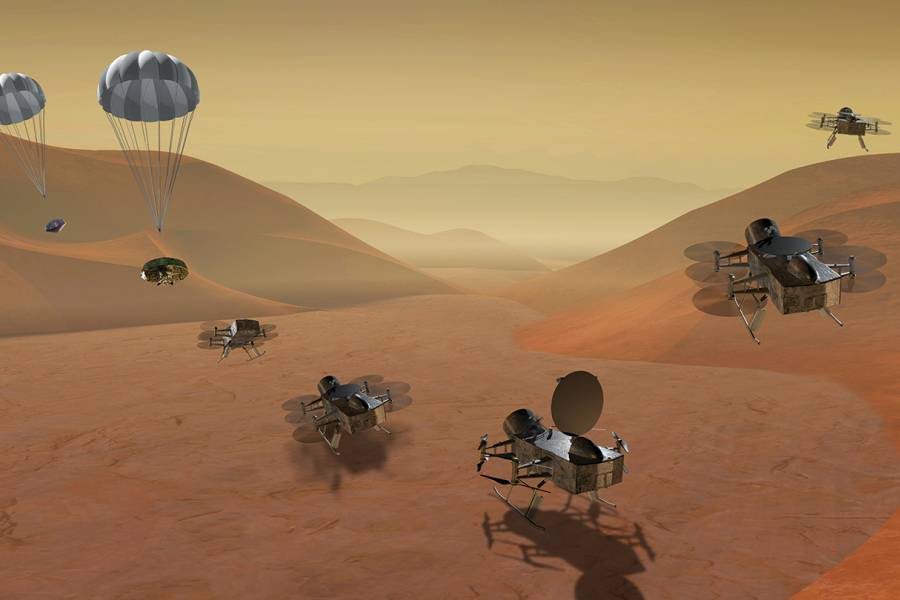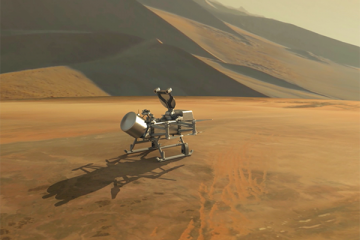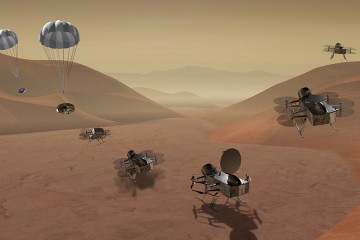In July 2000, the British magazine New Scientist published a cover story titled "Titan Here We Come." Written by Ralph Lorenz, a planetary scientist at the University of Arizona, the brief article made a case for rocketing a mobile lander to Titan, the largest moon orbiting Saturn. The first Mars rover, Sojourner, had covered about 100 meters of the Martian surface in 1997. Lorenz and other planetary scientists were more ambitious for Titan. At the time, no one knew what they'd find on the moon's surface. Would a land rover be able to move at all? What if there turned out to be a variety of geologic features scattered across the moon? Wouldn't it be great to sample several of them? Titan's dense atmosphere and low gravity would be ideal for aircraft, which could ferry scientific instruments from one site to another all over the moon. Researchers had already suggested balloons or even small airplanes. Lorenz came at the problem from a different angle: What about a plutonium-powered helicopter? "We should be in for a treat," Lorenz wrote, already anticipating a successful mission. "This world has some bizarre sights."
Yes, it does. Titan is the damnedest place. That's not a scientifically precise observation, but it's apt. Larger in diameter than Mercury, the moon has a nitrogen atmosphere full of complex organic molecules that is four times denser than Earth's. Titan has a hydrous silicate rock core that appears to be wrapped in a global subsurface ocean of water under an outer shell made of rock-hard water ice. Here it rains liquid methane that collects in rivers, lakes, and seas. There are possibly volcanoes that spew water and vast fields of dunes sculpted by wind and composed of organic sand. (On Earth, sand comes from erosion of rock. No one can explain how organic matter—that is, carbon-based material—can erode to become sand, but it does on Titan.) The moon's complex prebiotic chemistry—prebiotic as in prior to life—may mirror the conditions on Earth 4 billion years ago, before the emergence of the first terrestrial living organisms. There's even the remote but tantalizing possibility that somewhere on Titan, prebiotic has become biotic—that proteins or cellular life already exist. Not on the frozen, uninhabitable surface but perhaps in the subsurface liquid H2O.
In January 2016, NASA issued a community announcement that it would be soliciting proposals for missions to solar system planetary bodies as part of New Frontiers, a program of less expensive missions—under $1 billion each, which counts as less expensive in space exploration. The likely deadline for proposals would be April 2017, only 16 months away.
NASA's list of target worlds included Titan, and that caught the attention of scientists and engineers at the Johns Hopkins Applied Physics Laboratory. A handful of them met at APL to discuss their options. In 2011, they had proposed a mission that would land a floating science platform on one of the methane seas in Titan's northern hemisphere. NASA had turned it down, but APL could revise and resubmit the proposal, a common practice in space science. When they looked at NASA's specified mission dates, however, they knew that Titan's seas would be tilted out of direct contact with Earth, making that mission impossible. Lorenz, who by now worked for APL, was part of the meeting, and he had another thought.
What about that helicopter I talked about 16 years ago?
If all goes as planned, in 2026 a rocket will lift off with a payload named Dragonfly. An eight-rotor drone-style helicopter carrying a suite of scientific instruments, Dragonfly, designed and built by APL, will land on Titan in 2034 and fly from site to site, gathering data on the moon's atmosphere, surface composition, meteorology, and seismic activity. It is an audacious project that by space mission standards was assembled so quickly that some members of the APL team still sound a bit awestruck that they won the NASA contract. But they did, and now they're going to Titan.
When NASA added Titan to the list of New Frontiers targets, Cheryl Reed, manager of civil space program development at APL, arranged that first fateful meeting in January 2016. Ken Hibbard, now in charge of Dragonfly's engineering, was there. He says, "To Cheryl's credit, she was like, 'You have carte blanche to go play cowboy. Just come up with something really exciting.' We were just gonna throw something in and hope for the best." Douglas Adams, Dragonfly's spacecraft systems engineer, was part of that meeting, too. He recalls listening to Lorenz talk about his helicopter idea. "I thought about it for maybe 30 seconds and said, 'I think we can do it.' And off we go."
Many NASA mission proposals take 10 or 15 years to develop and win NASA's approval. The APL cowboys had less than a year and a half to submit its proposal. The first job was to assemble a team. They would need a principal investigator to run the show. The answer was right down the hall: Elizabeth Turtle, a planetary scientist and Titan specialist who had worked at APL since 2006. Turtle, known to everyone as Zibi, which is how she'd mispronounced her first name as a little girl, had a superb reputation as a planetary scientist. Sarah Hörst, whom Turtle recruited for the mission, says, "She is hands down one of my favorite people in planetary science, and I think anybody in the field would say that. Academic science can be very competitive, and people can be unkind. She's very fair and you can trust her with things that are important to your career. And she's a brilliant scientist." Plus Turtle had worked on the Cassini Saturn orbiter, which had landed a simple probe named Huygens on Titan on Christmas Day 2004. (Huygens, so far the only craft to land on Titan, gathered data for a few hours in the atmosphere and lasted about 90 minutes on the surface.)
Turtle said yes. When NASA selected Dragonfly, she became only the third woman ever to be PI on a NASA mission. "We didn't know much about Titan until the Cassini mission," she says. "It was a huge privilege to be part of that exploration. It took years before we really started putting together the puzzle of Titan as a system, and there's just so much more to understand. It's this icy moon in the outer solar system with these materials that fill the same roles as different materials on Earth. There's this familiarity of the environment that's so different in many ways but also reminiscent of home."
She knew Hörst, an exuberant young Johns Hopkins assistant professor of planetary science who had been studying Titan since she was 19, and who has applied to NASA to join the astronaut corps three times. Turtle sent Hörst a note asking if she wanted to join Dragonfly. "My response to her was, 'Sure.' That's literally all my email said," Hörst recalls. "It was such a compelling mission scientifically. I think every time somebody asked anybody for anything they all just said, 'OK, I'll do it. How fast do you want me to do it, and I'll do it 10 times better than you asked' because we were all so excited about the opportunity."
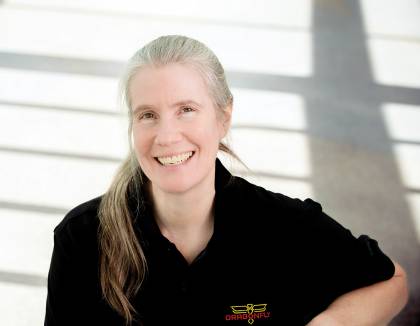
Image caption: Zibi Turtle
Image credit: Marshall Clarke
The team grew to several dozen people who would assemble the initial proposal. NASA's standard procedure is to evaluate competing ideas and announce two or three finalists, a step known in the space business as the "down-select." Each team that made it through down-select would be granted an additional year and some government funding to refine their concepts and resubmit them. NASA then would announce the mission in 2019. Says Hibbard, "From idea to mission, there are two major steps. Step One, you're supposed to win on science. In addition to providing meaningful science and benefiting the Titan community and the Saturn community, but the whole of planetary science? Then comes Step Two. The science is locked in, and NASA says here's what we didn't like about your proposal technically—go fix that and prove that on the technical side you can do this within the cost and schedule constraints."
From the start, the focus of the science was Titan's complex prebiotic chemistry, in the atmosphere and on the surface. Prebiotic chemistry is the set of complex molecules and chemical reactions that, as far we know, precedes the formation of living organisms. We can't go back in time on Earth to study this chemistry, but it's right there on Titan. Understand it, and we would accomplish a leap in solving how the prebiotic Earth became a planet teeming with life or, as Turtle succinctly puts it, "how chemistry becomes biology." She says, "We've got all the ingredients that we know to be necessary for life, at least familiar water-based life. We want to understand when you have this kind of environment and all of these components together, perhaps interacting for millions of years, what happens? How far does the chemistry progress?" And there's more: Titan has a methane cycle like Earth's water cycle. Could Titan's blend of chemistry lead to a previously unknown sort of methane-based biology?
To accomplish the science, the team settled on a set of instruments that would have to fit on a drone about the size of a Mini Cooper. Perhaps most important is the mass spectrometer that will be used to analyze material from the surface directly under the lander, so the engineers needed a mechanism to get samples from the surface into the instrument. They settled on a system that combines a drill with a pneumatic transfer system that would suck particles off the ground using an approximately 2-inch drill bit and a sort of interplanetary shop-vac. A second spectrometer, a gamma-ray neutron spectrometer, measures the bulk chemical composition of the surface around the lander. A third instrument would be more or less a Titan weather station and seismometer to measure atmospheric and surface conditions. Finally, there'd have to be a camera, which, perhaps inevitably, became known as DragonCam.
That was the scientific payload. Now, how was the whole thing going to fly? They enlisted experts on rotorcraft from Penn State University and determined that the optimal design would use eight rotors in sets of two, what's known as an X8 octocopter. For power, the copter would be designed to use electricity from a small plutonium-powered multimission radioisotope thermoelectric generator (for some reason, everyone prefers to call it the MMRTG). To fly, the drone would require more power than it could draw directly from the generator, so the MMRTG would charge a lithium-ion battery, something like the one that powers a Tesla sedan, and draw from that to turn the rotors. Radio transmissions take 70 to 90 minutes to get from Earth to Titan, so no one on Earth could pilot Dragonfly with a joystick. The aircraft would need an autonomous flight system to navigate from one landing site to another. And everything would have to survive vibration during the launch, eight years in space, a hypersonic entry to a Titan landing, and surface temperatures of around −290 Fahrenheit.
The team solved one problem after another, at least on paper, and prepared the massive document that they submitted to NASA in April 2017. It was an arduous process because mission proposals are extraordinarily detailed and complex documents. The authors must try to anticipate every critical query from reviewers to make the proposal as strong as possible. Lorenz described the process in an August 2015 article for The Space Review: "Usually there are hundreds of details that may appear in or affect different parts of the proposal—the power for an instrument, say—and as the design evolves, different sections get out of sync. This sort of inconsistency is just what reviewers love to catch, so how to track them? Our memory for page and section numbers (which are always changing anyway) is limited, but by printing the proposal out and pinning it up on the wall, we start to develop a spatial mapping of the information. ... There are probably two or three dozen rooms in NASA centers, aerospace companies, and a few universities decked with what is probably among the world's most expensive wallpaper."
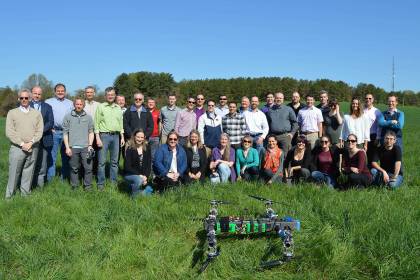
Image caption: The team of scientists working on Dragonfly—also known as Dragonflyers
Image credit: Johns Hopkins Applied Physics Laboratory
In all, the space agency received 12 proposals that pitched missions to Titan, Enceladus, Venus, comets, and various asteroids. Turtle says she didn't bother pondering their odds for success: "There's no way to assess chances, in my experience. There are so many different aspects of the decisions that review panels make, and from the proposer's perspective so many unknowns." Hibbard did ponder the odds: He thought APL had a 50-50 chance. A veteran of many NASA proposals, he knew it was rare for a mission to be accepted on the first try. "I was nervous. We got a late start. But on the flip side, the science was really amazing, right? This mission was exciting from the get-go, flying on another world. I mean, you can see the video game in your mind."
Eight months later, he was meeting with Turtle at APL when her cellphone rang. He knew the down-select announcement was imminent, and when he saw the caller was Curt Niebur, a NASA program scientist, he says, "My heart sank because it was the moment of truth, yes or no. Then I see the expression on Zibi's face. She lights up, her eyes are shining, she starts smiling, and I thought, Oh my god, I think we actually got through." Hörst was at Olin Hall on the Homewood campus, where she and faculty colleagues had gathered to listen to the audio feed of NASA's announcement. She had heard nothing from Turtle, so she'd brought a bottle of champagne in case APL won and a bottle of bourbon in case they lost. "I'm hearing nothing from Zibi, and I'm like, OK, don't get excited, because I'm not sure any of us really thought we were going to survive down-select," she remembers. "Then someone at APL texted me and said, 'There's a rumor that dragons fly.'" When the press conference began, Hörst had her laptop open. "I looked down, and there's an email from somebody who said it was us, and I slammed my computer closed and stood up and just started screaming."
Two missions had survived down-select: Dragonfly and CAESAR, a proposal from Cornell and the Goddard Space Flight Center to fly to a comet and return samples of it to Earth. APL's scientists and engineers now had a year to do detailed design work, testing, and development, as well as write what's known as the CSR, the concept study report. NASA had identified what it considered a number of significant weaknesses in APL's initial proposal, and a NASA site visit later produced dozens of additional questions. APL had to respond to every one. Douglas Adams recalls, "Two thousand eighteen was like a lost year for me. I just worked fanatically. We were staggering forward at the end." The original CSR ran to more than 1,000 pages, and to respond to all of NASA's questions, they added about 900 pages in about three weeks. The Dragonfly team turned in the final document and waited on NASA's decision, which the agency planned to announce in summer 2019. "Now I thought it was really ours to lose," Hibbard says. "Everybody we spoke to loved this mission. So, if we really did our job technically, given everything that was there and with the excitement and the quality of the science, I thought we had a really good shot at winning this."
NASA does not give competing teams much advance word on when it will announce its decision. On June 26, it issued a media advisory stating that it would introduce the new mission the following day. Reporters started messaging Hörst on Twitter, asking if she'd heard anything, which is how she learned of the impending press conference. The announcement was scheduled for 4 p.m., and Hörst knew that NASA would allow Turtle to tell the team if they'd won only an hour before the event. At about 1:50 p.m., Hörst was in Olin Hall when she got a note from Turtle: "Hey, we're going to watch the press conference at APL, so if you want to come down, you're more than welcome." Hörst says, "I stand there for a second, and I'm like, holy shit! She must already know the answer!" She hopped into her car, raced down to Laurel, and ran into the APL building where Turtle was waiting for her in the hallway outside a room. She didn't say a word, just opened the door so Hörst could see that it had been set up for a feed to the NASA press conference with a special backdrop and a model of Dragonfly. Hörst knew what that meant. "I just looked at Zibi, and then we started crying and hugging."
Adams had just boarded a plane when he got a text from Ken Hibbard. "He says, 'Where are you?' He does this all the time. 'I'm on a plane. What's up?' Thirty seconds later, I get a call from Zibi. OK. 'Hey, Zibi, what's up?' I figure she needs a reference or a figure or something. She says, 'Where are you?' 'I'm on an airplane.' 'Can you talk?' 'Yeah, what's up?' 'Doug, we won!' My response was classic: 'We won what?'"
Planetary scientists who specialize in distant worlds do not get many opportunities to do big science. Designing a mission and getting the proposal through NASA usually takes several years, assembling the mission takes more years, and then travel through space to the faraway target consumes more years after that. Turtle, Lorenz, and Hörst know that Dragonfly is a once-in-a-career opportunity.
Hörst was a 19-year-old Caltech undergraduate when a professor asked if she'd like to help on a project: He needed someone willing to spend a few hours each night observing Titan through a 14-inch teaching telescope, watching for evidence of methane storms. The team spotted a couple and Hörst says, "I think it was at that point that I really fell in love with Titan." She encountered the moon again when her doctoral adviser worked on Cassini data pertaining to Titan's atmosphere, and she recalls, "By then I was hooked. I've been studying Titan nonstop since 2005. It's been almost half my life at this point."
Though he's also worked on missions to Mars and Venus, Lorenz has been involved with Titan research for almost 30 years. His curiosity about the moon has led him to learn a number of scientific disciplines just so he could study it. "Titan is such a phenomenologically rich place, where all sorts of things are going on—chemistry, weather, sand dunes, waves and tides. I've strayed into so many disciplines and learned so many interesting things about these processes on Earth over the years because they apply to Titan, too."

Image credit: Johns Hopkins Applied Physics Laboratory
Fresh out of Southampton University in England with a bachelor's degree in aerospace systems engineering, he spent a year at the European Space Agency working on developing the Huygens spacecraft, which cemented his fascination with Titan. "For me, Dragonfly is the culmination of two decades of thinking about how to explore Titan after Cassini. I was very lucky to start my career just when Huygens began, and hopefully will retire after Dragonfly has spent a few years on Titan." In 1994, after earning a PhD in space sciences at the University of Kent, Lorenz came to the University of Arizona for a one-year postdoc, helping to create the first map of Titan using near-infrared images from Hubble that revealed the surface beneath the moon's opaque atmosphere. "That was what I went out for," he says, "but within a week of getting off the plane I bumped into a graduate student there. Five weeks later we got engaged and 18 months after that we were married." The graduate student was Zibi Turtle.
Now the real work begins. The Dragonfly team numbers in the hundreds now—some have begun calling themselves Dragonflyers—and will grow further before the project is complete. APL engineers must design the spacecraft, test and retest each component, assemble the lander, test it some more, resolve myriad problems that always arise, then ship Dragonfly to the launch site in April 2026. The work has to be all but flawless, completed on time and within the New Frontiers cost constraint. "We're doing something fairly audacious on a reasonably tight budget," Hibbard says. "It's surprising how fast you can spend a billion dollars." He lists the key challenges, which he calls "the tall poles": the surface flight system, the sampling apparatus, and accommodation of the MMRTG. "And then there are the unknowns, right? There's always that second category of things that are going to go wrong. They're going to crop up, and we're going to have to roll with the punches and find solutions."
The next several months will be spent assembling more team members, formalizing relationships with various suppliers, and diving into the preliminary design. Says Turtle, "The challenge in all missions, and especially in a mission that has different elements, is bringing everything together at the same time, having all of the development proceed at the right schedule so all of the different pieces come together and you don't get one part of the system defined and then have to come back and redefine it because something changes. Navigating on Titan autonomously is going to be one of the areas where we spend a lot of time in development and testing. Some of our instruments are based on instruments that are currently making measurements on the surface of Mars, but we have to adapt everything, to make sure everything can function in the Titan environment."
If everything works, Dragonfly will arrive on Titan in 2034, landing in the wonderfully named Shangri-La Dune Sea. The goal is for it to spend nearly three years on the surface, flying every 30 days or so, covering up to 175 kilometers to sample, measure, monitor, and beam data back to some very eager planetary scientists on Earth. "We know that from the first landing, we're going to immediately get answers to questions that we've had for decades," Hörst says.
A veteran scientist like Zibi Turtle understands the magnitude of the opportunity at hand with Dragonfly. "A lot of planetary exploration is repeated trying—many missions get proposed many times along the way. There are so many things that we want to do as scientists and we don't always get to do them. It's quite an honor to get to take this mission further."
Nearly 20 years ago, Ralph Lorenz ended his New Scientist piece with this: "Making any new space missions happen is not a trivial exercise, and it is certainly not for the impatient. ... It could be a long slog, but just imagine what might be waiting for us on Titan." Fourteen years from now, he and his APL colleagues will finally find out.
Posted in Science+Technology
Tagged applied physics laboratory, nasa, outer space, dragonfly




